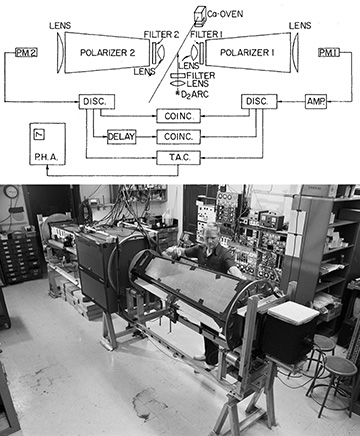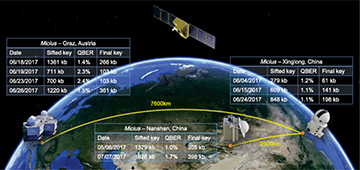![]()
John F. Clauser, Alain Aspect and Anton Zeilinger [Images: Wikimedia Commons / Ecole polytechnique Université Paris-Saclay / © Sepp Dreissinger]
In a 1935 paper, the quantum mechanics pioneer Erwin Schrödinger referred to entanglement between distantly separated particles as “not … one, but rather the characteristic trait of quantum mechanics, the one that enforces its entire departure from classical lines of thought.” This year, the Royal Swedish Academy of Science has awarded the Nobel Prize in Physics to three scientists—John F. Clauser, Alain Aspect and Anton Zeilinger—who used optical approaches to establish the reality of such quantum entanglement, and to solidify its place as a key practical resource in the development of quantum computers, quantum communications and more.
A long and (en)tangled debate
The achievements of Clauser, Aspect and Zeilinger used entangled photons to resolve a long-standing debate in the early history of quantum mechanics. Notwithstanding Schrödinger’s statement, no less a figure than Albert Einstein found the idea of nonlocal entanglement—which the ever-quotable Einstein famously referred to as spukhafte Fernwirkungen (“spooky action at a distance”)—impossibly paradoxical.
Einstein and two coauthors, Boris Podolsky and Nathan Rosen, summed up those apparent paradoxes in a celebrated 1935 Physical Review paper that is almost universally referred to as “EPR.” The EPR paper laid out a thought experiment that, the authors concluded, suggested that the quantum-mechanical description of reality wasn’t complete, and that local “hidden variables” must be at work in a system to explain the mischief of apparent nonlocal correlations.
Nearly 30 years later, however, the physicist John Stewart Bell published an equally famous paper dissecting the EPR paradox. Through a deep mathematical dive into the EPR thought experiment, Bell established that no hidden-variable theory could reproduce all of the results of quantum mechanics. And he derived a mathematical relation—the famous Bell inequality—whose violation would conclusively rule out local hidden variables and establish the presence of a genuine, nonlocal entangled state.
Taking Bell tests to the lab
Bell’s inequality, while massively significant as a theoretical construct, was not at first of much use experimentally; the result itself of a thought experiment, it couldn’t be squared with practical detector technology. The three 2022 physics laureates found ways to circumvent those difficulties, and to advance studies of entanglement firmly into the realm of experimental science.
Top: Experimental setup in Freedman and Clauser’s landmark 1972 demonstration. Bottom: CLauser with experimental apparatus. [Images: S.J. Freedman and J.F. Clauser, Phys. Rev. Lett. 28, 938 (1972) / Steve Gerber, Berkeley Lab] [Enlarge Image]
The first step in that direction was taken by John Clauser (then affiliated with the University of California, Berkeley, CA, USA), along with colleagues Michael Horne, Abner Shimony and Richard Holt—who together contributed another acronym, CHSH. In a 1969 paper in Physical Review Letters, the four proposed a tweak of Bell’s inequality that was compatible with existing technology, and an experimental setup to test it. Clauser and Stuart Freedman followed up three years later with another PRL paper demonstrating such an experiment using entangled photons—a demonstration that, the pair wrote, provided “strong evidence against local hidden-variable theories.”
Closing loopholes
Pathbreaking as the work of Clauser and colleagues was, it still left some annoying Bell-test “loopholes” unresolved. A series of landmark experiments conducted in 1981 and 1982 by the second 2022 laureate, Alain Aspect (Université Paris-Saclay, Paris, and École Polytechnique, Palaiseau, France), closed one such key loophole, related to locality.
Aspect, along with Phillipe Grangier, Gérard Roger and Jean Dalibard, designed a series of ingenious setups to take Bell-inequality violations to ever-greater levels of precision. One of the experiments used a configuration of two-channel polarizers to record what the paper’s authors called “the greatest violations of generalized Bell inequalities ever achieved.” Another, particularly celebrated experiment employed an acousto-optical switch to achieve 10-nanosecond-scale switching of photons in different paths. By randomly changing polarization settings on a timescale comparable to the time of flight of the entangled photons, Aspect was able to ensure complete independence and close the locality loophole.
From teleportation to quantum communications
The honoring of the third laureate, Anton Zeilinger (University of Vienna, Austria), recognizes the amazing accomplishments of his lab in building on the work of Bell, Clauser, Aspect and other workers to advance the study of entanglement—and to put it on a firm foundation as a resource for quantum information science and technology.
Groundbreaking work by Zeilinger and colleagues includes experiments in 1997 demonstrating the quantum “teleportation” of information; the “swapping” of entangled states, a key requirement for many quantum information systems; studies of entangled states involving more than two particles; and the development of emerging quantum networks. A spectacular example of the latter was the 2018 demonstration of a quantum-encrypted satellite link across 2400 km, between the lab of Zeilinger’s group in Vienna and the unit of one of his former students, Jian-Wei Pan, in China, using the Chinese quantum communications satellite Micius as the intermediary.
Artist view of 2018 China–Austria satellite link based on quantum entanglement. [Image: S.-K. Liao et al., Phys. Rev. Lett. 120, 030501 (2018)] [Enlarge Image]
“Do what you find interesting”
Zeilinger, reached by phone during the press conference announcing the prize, said he was “still kind of shocked” to receive the prize, but it was a “very positive shock.” After fielding journalist questions on quantum teleportation—some of them clearly influenced by the science-fiction version portrayed on Star Trek—he placed the accomplishments that led to the prize in the context of how they might inspire scientists in the future.
“This prize is an encouragement to young people,” Zeilinger said, adding that the recognition would not have come about “if not for the more than one hundred young people who’ve worked with me over the years and made all this possible.”
To such young scientists, Zeilinger firmly recommended going where their curiosity leads them. “My advice would be to do what you find interesting,” he said, “and don’t care too much about possible applications.”


